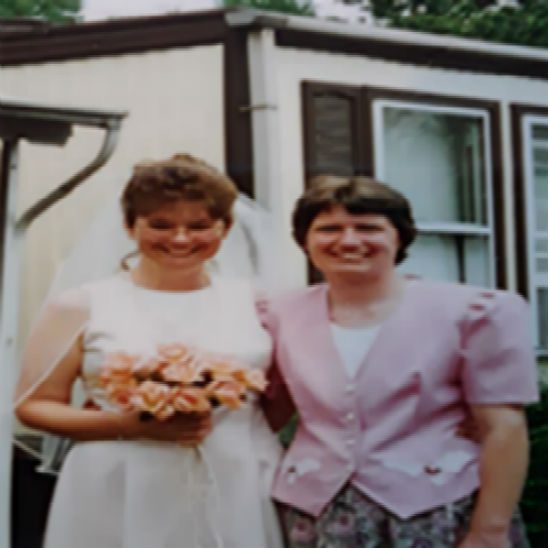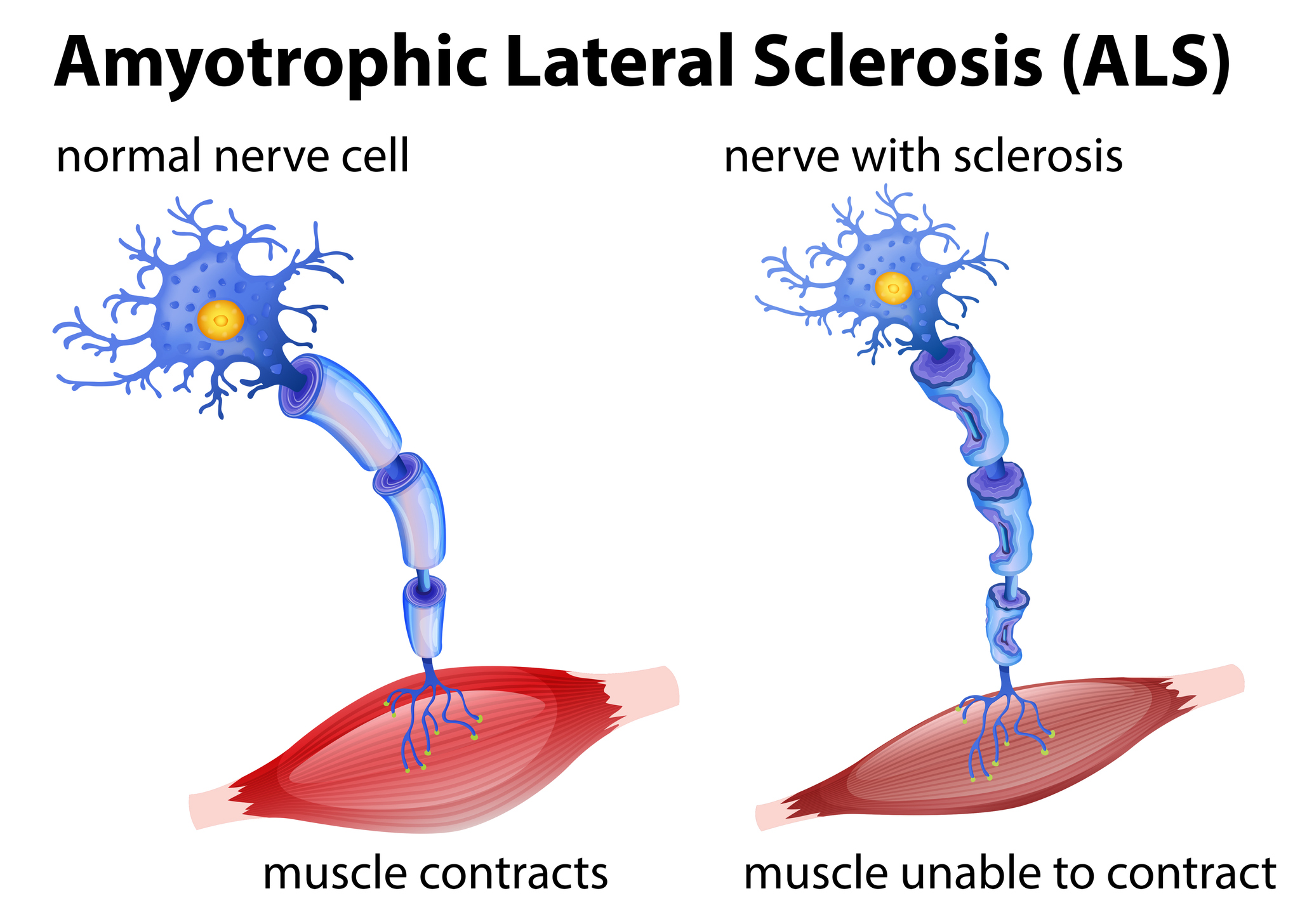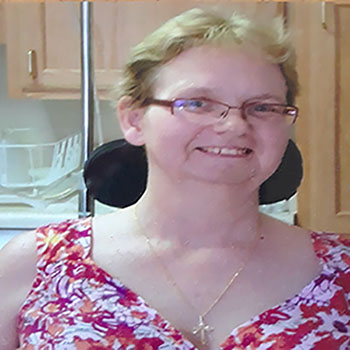In the spring and summer of 2014, another viral social media trend was born. People around the world began recording or streaming themselves dumping buckets of ice and cold water over their head, and then challenging others to do the same. The trend has been performed each summer ever since, with participants ranging from community gatherings and individuals in their backyards to celebrities like Oprah Winfrey, Bill Gates, Lebron James and Cristiano Ronaldo. The trend also had a purpose: to raise awareness and encourage donations toward fighting and finding a cure for amyotrophic lateral sclerosis or ALS.
But for Therese Kambach, a 57 year-old woman of Warrenton, Virginia, that awareness came too late. It was a dark and stormy evening in 2010–your typical setting to proceed something bad–when a large storm with the risk of tornadoes came through the area. When it had passed, Therese heard the voice of her best friend, Cheryl, who was the same age and lived in Greenbelt, Maryland. The two had been best friends since they were kids and, after the storm had past, Cheryl was calling to make sure everything was okay.
Therese immediately knew that something was terribly wrong.
“Cheryl developed a very noticeable slur in her speech,” she said. “At first, the doctors thought she had a stroke, but she had no other stroke symptoms. I often had to ask her to repeat herself. But when she learned the doctors wanted to test her for ALS, she learned all she could about it, and prayed with all her heart that the test would show she did not have ALS.”

Also known as Lou Gehrig’s disease, ALS is a progressive neurodegenerative disorder where the nerve cells in the brain and spinal cord that control muscles gradually die, resulting in the muscles weakening throughout the body. This leads to paralysis and seriously inhibits the patient’s ability to communicate.
ALS, which is rare and affects approximately 30,000 people in the United States with no known cause, is the traumatic change in life that no one either expects or wishes to face. When her diagnosis was confirmed, Cheryl–who had also battled and defeated breast cancer not long before–was terrified for herself, worried about her ailing husband Frank and who would take care of him and, like her best friend, was angry that the future she had hoped for would never happen. Patients who receive the ALS diagnosis are initially given an estimated 2-5 years before the disease kills them, and are advised to get their affairs in order.
“Everything about ALS is bad,” said Therese. “It’s hard to determine what is the worst experience. Early on, it’s probably the loss of independence. One needs help walking, using the bathroom, bathing. Later on, the inability to communicate is probably the hardest part. The patient becomes trapped in a body that refuses to do what the brain tells it to do, but doesn’t lose touch with reality. The disease robs a person of independence, comfort, means of communication, ability to eat and ultimately the ability to breathe. During the journey, the victim of ALS tires easily (due to less oxygen taken in with each breath) and experiences stabbing pains throughout the body. They come and go at random times with no warning, and there’s little anyone can do to relieve them.”

The disease can also have different, heavy affects on the mind. Patients can experience frontotemporal dementia, which can change how the victim thinks, communicates, behaves or makes decisions, and can even lead to aggression. Another condition they may experience is called pseudobulbar affect, which causes them to display outward expressions of emotions that they are not really feeling. Patients can burst into sudden episodes of laughing or crying without warning.
The diagnosis of ALS is also emotionally devastating for both the patient and their loved ones. All must adjust to a new way of life with the disease. Without a job to go to every day, shopping, outings, and housework, one’s days and nights become one. There were the doctors appointments and places one can go in a wheelchair if one has a vehicle to transport the patient in the wheelchair. Eventually, and all too soon, moving from the wheelchair to car and back becomes an exhausting adventure for both the ALS patient and the person helping. These traumatic changes and the symptoms of the disease can cause patients to fall into isolation, withdrawing from social interactions and situations, which can lead to anxiety and depression. Symptoms of depression in ALS patients is even more difficult to identify due to the disease’s effect on the mind and the patient’s ability to express emotions.
According to Therese, the worst thing a friend or family member can do is avoid the ALS patient because he or she is afraid or feels inadequate to handle what is happening. This causes an ALS patient incredible grief even if the patient says he or she understands. Usually, ALS patients do understand, but time is short for them so words that need to be said and feelings that need to be expressed may go unsaid or unexpressed. Cheryl’s own brother went with her to the first couple of doctors appointments, but then avoided her as the disease progressed until Therese called him to say that if he wanted to see her alive, he’d better get over to the apartment. Her sister didn’t show up until a couple of hours before she passed. This caused Cheryl great and unnecessary pain during a time when every day was filled with suffering.
“I was heart-broken,” Therese said. “We had always hoped to grow old together. Then I researched ways to help.”
According to Therese, the best thing to do to help alleviate some of the trauma all around is to be present for your friend or family member, and listen to them. Do research and offer to help in any way. This may involve help with bathing, personal hygiene, household chores, yard work, transportation, shopping, etc. In addition, encourage the patient to take advantage of any support, programs, or ALS-specific devices as soon as the patient becomes eligible.
In the beginning, Cheryl was loaned a text-to-speech machine so that she could type what she wanted to say. When she lost the use of her hands and couldn’t type, Therese made a speech board so that all Cheryl had to do was point to words, but she would tire easily and become frustrated. As the disease progressed and she couldn’t move her arms, they resorted to yes and no questions where she could give a thumbs up or down to answer, or blink yes or no.
With advancements in technology and the help of their caregivers and loved ones, many ALS patients are able to manage the symptoms and to live fulfilling lives. Some have even gone on to do great things in arts and sciences. Jason Becker was a rising guitarist when he was diagnosed in 1990. Tony “Temp One” Quan, an iconic graffiti artist out of Los Angeles, was diagnosed in 2003. Both are completely paralyzed and require 24-hour care, but that hasn’t stopped them from their work. They use eye-tracking technology that allows them to draw, type and speak simply by moving their eyes. Becker released a seventh solo album this past December. And, of course, there’s the acclaimed physicist and cosmologist Stephen Hawking.
Though she had no aspirations of releasing a metal album or study the stars, ALS didn’t not stop Cheryl from living the rest of her days as best as she could. Experiencing and sharing love became her primary work, and she did everything she could to make her ALS journey as easy as possible for both her and her husband. She set all her affairs in order while she was still able to sign her own name. She learned about all the resources available to those with ALS and, with Therese’s help, moved to an apartment in Stafford, Virginia, where it was easy for both her and Frank to move around. When the funds from her retirement plan became available, she even planned and paid for her funeral, her husband Frank’s funeral and Jerry’s (Frank’s brother) funeral so all Frank had to do when she died, was call the funeral home.
On Christmas Eve, 2012–after she had passed–her husband Frank returned home to find a Christmas ham that had been ordered and delivered to his front door…from his late wife.
“Cheryl was a very faith-filled person,” said Therese, “and she lived for visits from family and friends. She, more than almost anyone I know, radiated love. She prayed a lot, but she was a doer. Not actively being involved in people’s lives was very hard for her. She accepted that there was no cure, but she fought hard to live every moment she could. I would say visits and prayer helped her, but she really had no choice but to go through it.”
“Prayer and the courage Cheryl demonstrated also helped me,” Therese continued. “Watching her suffer certainly made it easier to accept her passing, and knowing she was free also helped.”

April 25th, 1961-December 10th, 2012
If you have a friend or loved one who is struggling through this horrible disease, you can find information and resources through the ALS Association and Team Gleason. Consider the Online M.S. in Psychology, M.S. in Counseling or the Psy.D. in Clinical Psychology if you want to build the skill set to help ALS patients and their families through their difficult journeys.

